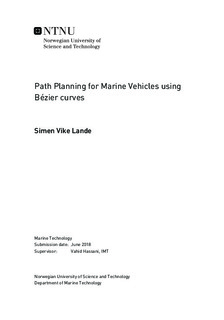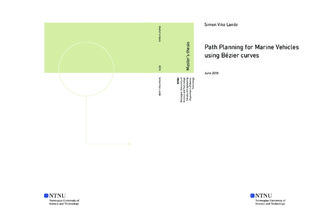| dc.description.abstract | The maritime sector have over the last few years witnessed a growing demand for the development of Autonomous Surface Vehicles (ASV), capable of performing complex tasks with high associated risk. Central in this development is the need for a new generation of advanced guidance, navigation and control (GNC) systems, enabling the ASV to work in any unstructured environment without human supervision. To that end, the availability of efficient and intelligent path planning algorithms are of paramount importance. The present thesis aims to contribute to this development, and proposes a path planning algorithm incorporating in its formulation, the dynamics of the vehicle and information about obstacles and other vehicles in its vicinity.
The proposed path generation algorithm is formulated within the framework of optimization, exploiting Bézier curves as the basis for the generation of a rich set of paths. Further, by the use of the differential flatness property of the vehicle, a cost is assigned to each path, reflecting the dynamic capabilities of the vehicle on that path. The proposed algorithm is capable of generating geometric and parametric continuous paths, while accounting for environmental constraints such as obstacles. Furthermore by constraining the curvature of the path, the algorithm ensures that the turning radius never exceeds the physical limitations of the the vehicle. The present thesis includes a description of the implementation of the proposed algorithm in MATLAB, commenting on the some of the decisions made in this process.
Finally, a series of numerical simulations are presented, illustrating the efficacy and capabilities of the proposed algorithm. The simulation results presented, differ in boundary conditions and environments, thus highlighting some of the versatility of the proposed algorithm. In the obtainment of results, an issue related to the reliability of the algorithm were reveled, thus further revealing a direction for future work. On this remark, albeit with some persisting challenges, it is concluded that the Bézier curve is a worthy candidate for future considerations, offering a vast amount of possibilities and versatility. | |

